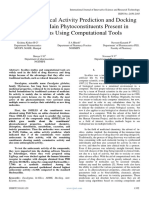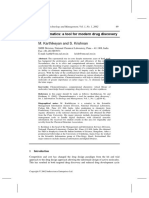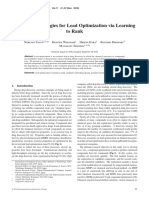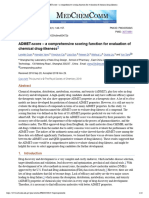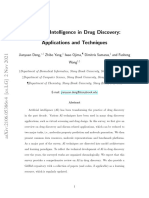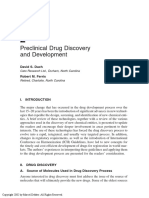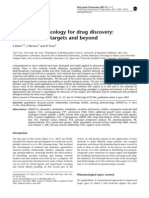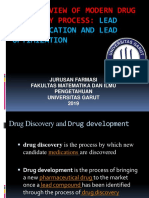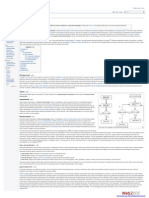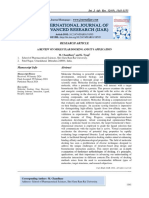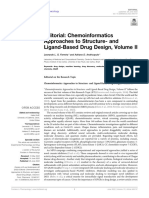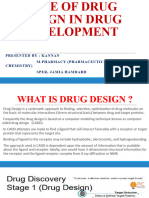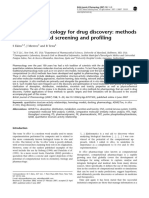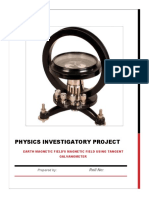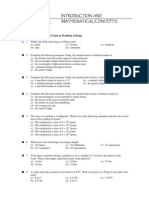Professional Documents
Culture Documents
Multi-Label Long Short-Term Memory-Based Framework To Analyze Drug Functions From Biological Properties
Original Title
Copyright
Available Formats
Share this document
Did you find this document useful?
Is this content inappropriate?
Report this DocumentCopyright:
Available Formats
Multi-Label Long Short-Term Memory-Based Framework To Analyze Drug Functions From Biological Properties
Copyright:
Available Formats
Volume 7, Issue 7, July – 2022 International Journal of Innovative Science and Research Technology
ISSN No:-2456-2165
Multi-Label Long Short-Term Memory-Based
Framework to Analyze Drug Functions from
Biological Properties
Pranab Das
Assam, India
Abstract:- Drug function identification from the drug The use of biological properties of the drugs is increasing
properties is important in drug discovery. Each year to discover new drug-drug interaction [8, 9, 10] and side
billions of dollars are spent on empirical testing of the effects identification [11, 12, 13, 14]. However, biological
drugs, which is costly, chemical wastage, and time- properties are not yet utilized to analyze drug function. Such a
consuming. The computational experiments would help study efficiently analyzes drug function from the biological
reduce drug discovery time and cost significantly. Most of properties of the drug. In the field of pharmacology,
the existing works have focused on single-label drug biotechnology, drug discovery, development, and design,
function identification. However, the capability of the analyzing the drug functions are essential in discovering new
drug's biological properties (transporter, target, carrier, drugs efficiently. A drug can have multiple drug functions.
and enzyme) has not yet been explored for multiple drug Therefore classifying a drug into different drug functions is a
function identification. Identifying drug function is a multi-label task [15, 16]. The analysis of drug function can be
multi-label classification problem. So, in the present work, carried out using a Multi-Label Long Short-Term Memory
a multi-label long short-term memory-based (MLLSTM). Unlike single label identification classification,
framework has been proposed for identifying drug the multi-label identification approach identify one or more
function. The data related to biological properties has been drug functions at the same time. This work demonstrates how
extracted from DrugBank, and drug functions are the multi-label long short-term memory approach is used on
collected from PubChem. The proposed framework biological drug properties to analyze various drug functions
performance has been found promising in terms of derived from the medical subject heading (MeSH) [17]. The
accuracy, precision, recall, F1, ROC-AUC score, and common problem in multi-label classification tasks is that it
hamming-loss, and it achieved the highest accuracy of faces a class imbalance problem. A multi-label dataset with
95.80%. class imbalance is a complex problem, and the result may be
affected. So, Multi-Label Synthetic Minority Over-Sampling
Keywords:- Multi-Label, LSTM, Biological Properties, Drug Techniques (MLSMOTE) have been used to address the class
Function, Machine Learning. imbalance issue [18].
I. INTRODUCTION This paper employs a multi-label long short-term
memory framework on biological properties to analyze drug
Drug development is one of the essential procedures in function. The literature survey shows that the multi-label
pharmaceutical manufacturing production. Analyzing drug analysis of drug function is addressed before using only a 2D
function is a vital part of the drug discovery, development, and chemical structure. However, analyzing multiple drug
design. The process of the drug development pipeline is a functions for specific drug-using biological properties has not
complicated, expansive, resource-consuming, chemical been explored yet. This type of drug properties may use in drug
wastage, and time-needed process [1, 2]. There is a need to development to analyze drug functions.
analyze drug function efficiently to avoid the maximum cost
and time; hence, different computational methods are The main motivation in this work is to check whether
constantly being developed for analysing drug function. drug functions are trained with the biological properties of the
Computational methods are essential to minimize the time and drug with a multi-label long short-term memory approach to
cost during drug design and discovery [3, 4]. Long Short-Term analyze drug function efficiently.
Memory (LSTM) is a promising computational drug
development approach for a new drug [5, 6, 7]. Several The organization of the work is as follows: related work
methods are applied in drug development experiments to get is summarized in section II. The architecture for the proposed
early information about the drug. LSTM techniques provide framework and drug properties has been described in section
the various benefits that help in drug discovery and decision- III. In section IV, parameter values for classification models
making on high-quality data for well-specified questions. and experimental results have been presented. Finally, in
Recently, LSTM has demonstrated its usefulness in the drug section V, the outcome of the experimental analysis of drug
discovery process. function has been concluded.
IJISRT22JUL448 www.ijisrt.com 1283
Volume 7, Issue 7, July – 2022 International Journal of Innovative Science and Research Technology
ISSN No:-2456-2165
II. RELATED WORK Most of the researchers used biological properties as input
features to identify drug targets, drug-drug interactions, and
Meyer et al. [19] identify drug function by employing adverse drug reactions. However, biological properties are not
convolution neural networks on the 2D structure and a random yet utilized as an input feature to a computational model to
forest classifier on the 1D structure. The authors collected analyze drug function.
functions of drugs, chemical 2D structure, and 1D structure
from the PubChem website. Further, they identify single-label The literature survey shows that the multiple drug
drug function for a particular drug from the chemical 1D function identification for a specific drug has been addressed
structure. They also showed how multi-label classification through the only 2D chemical structure. However, identifying
performs to identify multiple drug functions for a particular more than one drug function for a particular drug at the same
drug from the 2D chemical structure of drugs. In [20], the time using biological properties has not been utilized, which
authors employed a semi-supervised method named as has established the principle of the work in this paper.
Multicontrastive based on the 2D structure to identify the
function of a drug. This approach achieves better class III. ARCHITECTURE OF THE PROPOSED
identification accuracy than the different existing semi- FRAMEWORK
supervised methods. The authors collected the drug 2D
structure from PubChem and DrugBank, and 12 drug functions This section describes the problem statement, biological
from PubChem. For implementing their experiments, they drug properties utilized to identify drug function, and the
used the ResNext model. In conclusion, the authors find their framework to solve the stated problem. Let Drug = {Drug1,
approach shows significantly better results than the other Drug2, Drug3, ..., Drugk, ..., Drugm}be the set of drugs, X =
existing approach, such as Pi-model, VAT, MixMatch, and {transporter, target, carrier, and enzyme} be the set of features
Pseudo-labeling. Aliper et al. [21] showed how deep neural of drug properties, and Drug_Function = {Function1,
networks and support vector machine classifiers were applied Function2, Function3, ..., Function l, ..., Functionn} be the set of
on large transcriptional response datasets (gene expression drug function where each Function l represent the drug function
data) to analyze the drugs' pharmacological characteristics for a Drugk with drug features X. A drug Drugk can have
(drug functions). The authors use 12 drug functions and multiple drug function at the same time. Therefore, classifying
consider only those drugs that belong to only one drug function a drug into various drug function can be viewed as a multi-
class. Further, they collected gene information for three cell label drug function identification problem, Fig. 1 presents the
lines for 6p78 drugs over PC-3, A549, and MCF-7 cell lines representation of multi-label drug function for drug using their
from the LINCS L1000 website to analyze drug functions. In corresponding drug properties. Table- I shows the multi-drug
their experiment, the deep neural network model performs function for a specific drug, whose PubChem CID is
better than the support vector machine. 134688985 (drug name: Hyoscyamine sulfate), which has
three drug function; Cardiovascular (C), Central Nervous
In drug development, biological properties may use to System (CNS), and Respiratory (R).Abbreviations and
identify function of a drug. These properties (transporter, Acronyms
target, carrier, and enzyme) are widely used in drug discovery.
Table I: Example of multiple drug function for a drug.
PubChem CID C CNS Dermatological Urological …… R
134688985 1 1 0 0 0 1
Hence, the multi-label identification task is essential to identify multiple drug function based on the biological properties of
drug. The aim of the multi-label identification of drug function is to assign multiple labels (drug function) for a drug Drug k, which
input is related to a collection of drug features (X), and output is a set of possible Drug_Function.
Fig. 1. Multi-label drug functions representation.
IJISRT22JUL448 www.ijisrt.com 1284
Volume 7, Issue 7, July – 2022 International Journal of Innovative Science and Research Technology
ISSN No:-2456-2165
A. Dataset Description results. So, a method named MLSMOTE has been taken.
In the proposed work, the drugs' biological information MLSMOTE algorithm assumes that a multi-label dataset may
are used to identify drug function. The detailed description of have one or more minority labels. In MLSMOTE, first, select
the biological information and drug function are given below- the minority labels. Once a sample is selected which is belongs
to minority labels, the MLSMOTE finds its nearest neighbor.
Drug Function After that, a set of synthetic sample features is generated by
Drug function is the adeptness of a specific drug interpolation method.
(bioinformatics substance) to treat the targeted bodily part.
These biochemical substances have been utilized to diagnose,
cure, prevent or treat an ailment of any living tissue, which are
the essential matters of the drug function. The drug function
dataset contains a drug function with its corresponding
PubChem CID extracted from PubChem [22]. Although
PubChem consists of 20 high-level drug function, 12 drug
function have been taken in this paper, described previously in
Meyer et al. Drug function are represented with a well-ordered
list of binary numbers 1 and 0 to indicate the presence and
absence of drug function.
Biological Properties
Biological properties are also crucial in silico
experiments to drug discovery and development. In this work,
transporter, target, carrier, and enzyme are used to classify
drug function. The popular drug information database
DrugBank [23] is used to retrieve the biological information.
After mapping the drug biological properties with the drug Fig. 3. Frequency of class distribution on protein dataset.
function, it contains 1108 drugs corresponding to 12 drug
functions. C. Proposed Methodology
For identifying drug functions, the input is related to
The dataset with biological properties and drug function biological features, and the output is the drug functions of a
has been illustrated in Fig. 2, Where Functionn is the total particular drug. One drug may have more than one drug
amount of drug function (n=12) and transporter, target, carrier, function, so it belongs to the Multi-label task. A framework
and enzyme are the properties of drugs. for the proposed methodology has been represented
diagrammatically in Fig. 4. In the proposed methodology. For
solving multi-label drug function identification task, a multi-
label supported LSTM approach is proposed. Finally,
MLLSTM classification algorithm performance is evaluated
using different performance measures such as ROC-AUC,
precision, hamming-loss, accuracy, recall, and f1 score.
Fig. 2. Dataset preparation for the drug function
identification.
B. MLSMOTE for Handling Class Imbalance
The popular and frequent problem in the Multi-label
classification approach is unequal class distribution. When the
number of class are not equal, class imbalance occurs in the
dataset. The dataset with the frequency of class distribution has
been illustrated in Fig. 3. In Multi-label classification learning,
a dataset that has a class imbalance problem is a real-world
obstacle complex problem that can cause result degradation.
Dealing with this type of data is very important to get optimal Fig 4: Work flow of identifying drug functions from
biological properties.
IJISRT22JUL448 www.ijisrt.com 1285
Volume 7, Issue 7, July – 2022 International Journal of Innovative Science and Research Technology
ISSN No:-2456-2165
IV. PRAMETER VALUES FOR CLASSIFICATION observed that the performance of the MLLSTM does not
MODELS AND EXPERIMENTAL RESULTS improve as the number of hidden layer is increases. The
MLLSTM model performs well on one hidden layer with 64
A. Parameter Values for MLLSTM Model unit, and it achieved the highest accuracy. The performance of
A Multi-Label LSTM framework have been proposed to distinct units on each layer is shown in Table II. In the input
solve the multi-label drug function identification task. The layer return_sequence set to True, Adam is used as optimizer
proposed MLLSTM framework has been implemented in with binary_crossentropy as a loss function. The epoch is set
google colab using Python language (3.7.13 version). Keras to 10 and threshold is set to 0.5. If the probability of output is
and TensorFlow, with the help of sequential API is used to greater than 0.5, then the class label is assigned for that test
build the proposed model. The outcome of the MLLSTM sample; otherwise not. Learning rate 0.001 and tanh activation
framework is varied by the different number of hidden layer function is used for hidden layer, and sigmoid recurrent
and units in each layer. The MLLSTM obtained better activation is set for output layer. The output layer neuron is set
accuracy when the unit of the input layer was set to 16 and an equal number of labels (12 drug functions) and other
dropout 0.2 after that input and hidden layer. Further, it is parameters are set as default.
Input, Hidden Layer Sizes Accuracy Precision Recall F1 Score ROC-AUC Hamming-Loss
16, 16 94.40 % 90.71% 87.34% 89% 97.59% 5.59%
16, 32 94.30% 91.88% 85.52% 85.55% 97.75% 5.66%
16, 64 95.80% 92.05% 91.11% 91.60% 98.15% 4.23%
32, 32 92.20% 91.70% 76.14% 83.20% 97.70% 7.82%
32, 64 90.40% 91.04% 69.28% 78.69% 97.46% 9.64%
Table II: Results of the MLLSTM approach on biological properties to identify drug functions.
B. Results
The outcomes of the experiment to identify drug function
have been discussed in this section. The biological properties
(transporter, target, carrier, and enzyme) were utilized to
determine the drug function by employing a multi-label LSTM
framework. The performance of the MLLSTM framework on
biological properties has been presented in Table II.
It can be observed from Table II that the performance of
the MLLSTM with input layer unit 16 and hidden layer unit
64 is comparatively better than the other hidden input layer
unit. The MLLSTM model achieved the highest accuracy of
95.80%, precision score of 92.05%, recall value of 91.11%, F1
score of 91.60%, ROC-AUC score of 98.15%, and hamming-
loss of 4.23%. The ROC-AUC score of the different hidden
units of MLLSTM is of the proposed framework shown in Fig. Fig. 6. ROC curve of MLLSTM classifier on biological
5, Fig. 6, Fig. 7, Fig. 8, and Fig. 9. properties for input and hidden layer unit 16 and 32
respectively.
FIG. 5. ROC CURVE OF MLLSTM CLASSIFIER ON BIOLOGICAL Fig. 7. ROC curve of MLLSTM classifier on biological
PROPERTIES FOR INPUT AND HIDDEN LAYER UNIT 16 AND 16 properties for input and hidden layer unit 16 and 64
RESPECTIVELY. respectively.
IJISRT22JUL448 www.ijisrt.com 1286
Volume 7, Issue 7, July – 2022 International Journal of Innovative Science and Research Technology
ISSN No:-2456-2165
REFERENCES
[1]. Mohs, Richard C., and Nigel H. Greig. "Drug discovery
and development: Role of basic biological
research." Alzheimer's & Dementia: Translational
Research & Clinical Interventions 3.4 (2017): 651-657.
[2]. Taylor, David. "The pharmaceutical industry and the
future of drug development." (2015): 1-33.
[3]. Hochreiter, Sepp, Guenter Klambauer, and Matthias
Rarey. "Machine learning in drug discovery." Journal of
Chemical Information and Modeling 58.9 (2018): 1723-
1724.
[4]. Vamathevan, Jessica, et al. "Applications of machine
learning in drug discovery and development." Nature
reviews Drug discovery 18.6 (2019): 463-477.
[5]. Chen, Hongming, et al. "The rise of deep learning in drug
Fig. 8. ROC curve of MLLSTM classifier on biological discovery." Drug discovery today 23.6 (2018): 1241-
properties for input and hidden layer unit 32 and 32 1250.
respectively. [6]. Liu, Xiangyu, et al. "Long short-term memory recurrent
neural network for pharmacokinetic-pharmacodynamic
modeling." International journal of clinical
pharmacology and therapeutics 59.2 (2021): 138.
[7]. Mouchlis, Varnavas D., et al. "Advances in de novo drug
design: From conventional to machine learning
methods." International journal of molecular
sciences 22.4 (2021): 1676.
[8]. Ferdousi, Reza, Reza Safdari, and Yadollah Omidi.
"Computational prediction of drug-drug interactions
based on drugs functional similarities." Journal of
biomedical informatics 70 (2017): 54-64.
[9]. Ibrahim, Heba, et al. "Similarity-based machine learning
framework for predicting safety signals of adverse drug–
drug interactions." Informatics in Medicine Unlocked 26
(2021): 100699.
[10]. Dere, Selma, and Serkan Ayvaz. "Prediction of drug–
drug interactions by using profile fingerprint vectors and
protein similarities." Healthcare informatics
Fig. 9. ROC curve of MLLSTM classifier on biological research 26.1 (2020): 42-49.
properties for input and hidden layer unit 32 and 64 [11]. Liu, Mei, et al. "Large-scale prediction of adverse drug
respectively. reactions using chemical, biological, and phenotypic
properties of drugs." Journal of the American Medical
V. CONCLUSION Informatics Association 19.e1 (2012): e28-e35.
[12]. Wang, Chi-Shiang, et al. "Detecting potential adverse
The proposed methodology identifies drug functions by drug reactions using a deep neural network
analyzing the biological properties of drugs by employing a model." Journal of medical Internet research 21.2
multi-label long short-term memory-based framework. The (2019): e11016.
drug function identification power of biological properties is [13]. Jamal, Salma, et al. "Predicting neurological adverse
sufficient. The proposed multi-label long short-term memory- drug reactions based on biological, chemical and
based framework achieved the highest accuracy of 95.80% on phenotypic properties of drugs using machine learning
the biological properties. Based on the achieved result, it can models." Scientific reports 7.1 (2017): 1-12.
be said that the biological properties of the drug are essential [14]. Jamal, Salma, et al. "Computational models for the
for identifying the drug's function. Finally, this paper explores prediction of adverse cardiovascular drug
a multi-label long short-term memory-based approach to reactions." Journal of translational medicine 17.1
identifying multiple drug functions. (2019): 1-13.
IJISRT22JUL448 www.ijisrt.com 1287
Volume 7, Issue 7, July – 2022 International Journal of Innovative Science and Research Technology
ISSN No:-2456-2165
[15]. Read, Jesse, et al. "Classifier chains for multi-label
classification." Machine learning 85.3 (2011): 333-359.
[16]. Zhang, Min-Ling, et al. "Binary relevance for multi-label
learning: an overview." Frontiers of Computer
Science 12.2 (2018): 191-202.
[17]. Lowe, Henry J., and G. Octo Barnett. "Understanding
and using the medical subject headings (MeSH)
vocabulary to perform literature searches." Jama 271.14
(1994): 1103-1108.
[18]. Charte, Francisco, et al. "MLSMOTE: Approaching
imbalanced multilabel learning through synthetic
instance generation." Knowledge-Based Systems 89
(2015): 385-397.
[19]. Meyer, Jesse G., et al. "Learning drug functions from
chemical structures with convolutional neural networks
and random forests." Journal of chemical information
and modeling 59.10 (2019): 4438-4449.
[20]. Sahoo, Pracheta, et al. "MultiCon: a semi-supervised
approach for predicting drug function from chemical
structure analysis." Journal of Chemical Information and
Modeling 60.12 (2020): 5995-6006.
[21]. Aliper, Alexander, et al. "Deep learning applications for
predicting pharmacological properties of drugs and drug
repurposing using transcriptomic data." Molecular
pharmaceutics 13.7 (2016): 2524-2530.
[22]. Kim, Sunghwan, et al. "PubChem 2019 update:
improved access to chemical data." Nucleic acids
research 47.D1 (2019): D1102-D1109.
[23]. Wishart, David S., et al. "DrugBank 5.0: a major update
to the DrugBank database for 2018." Nucleic acids
research 46.D1 (2018): D1074-D1082.
IJISRT22JUL448 www.ijisrt.com 1288
You might also like
- Small Molecule Drug Design: Virtual Screening and Docking ApproachesDocument20 pagesSmall Molecule Drug Design: Virtual Screening and Docking ApproachesDORA ROJASNo ratings yet
- Admet, Biological Activity Prediction and Docking Studies of Main Phytoconstituents Present in Eucalyptus Using Computational ToolsDocument12 pagesAdmet, Biological Activity Prediction and Docking Studies of Main Phytoconstituents Present in Eucalyptus Using Computational ToolsInternational Journal of Innovative Science and Research TechnologyNo ratings yet
- Deep Action An Approach On The Basis of Deep Learning For The Prediction of Novel Drug-Target InteractionsDocument6 pagesDeep Action An Approach On The Basis of Deep Learning For The Prediction of Novel Drug-Target InteractionsInternational Journal of Innovative Science and Research TechnologyNo ratings yet
- Various Techniques in Drug Synthesis Term PaperDocument14 pagesVarious Techniques in Drug Synthesis Term PaperUmair MazharNo ratings yet
- Unit 5-Bioinformatics-DRUG DISCOVERY-02.01.22Document8 pagesUnit 5-Bioinformatics-DRUG DISCOVERY-02.01.2220SMB24 - ShafanaNo ratings yet
- Drug Designing 1Document2 pagesDrug Designing 1ShreyaChakladarNo ratings yet
- 06 - Chapter 1Document37 pages06 - Chapter 1Vikash KushwahaNo ratings yet
- In-Silico Drug Designing: - Drug Discovery and DevelopmentDocument3 pagesIn-Silico Drug Designing: - Drug Discovery and DevelopmentSeemron BiswalNo ratings yet
- Chemoinformatics: A Tool For Modern Drug Discovery: M. Karthikeyan and S. KrishnanDocument14 pagesChemoinformatics: A Tool For Modern Drug Discovery: M. Karthikeyan and S. KrishnanSandeep WasureNo ratings yet
- 1398857738Document11 pages1398857738Marisa dra anggraNo ratings yet
- Recent Advances in Rational Drug Design: Paramjeet Kaur, Akashdeep, MukulDocument35 pagesRecent Advances in Rational Drug Design: Paramjeet Kaur, Akashdeep, MukulParamjeet Kaur Paramedical SciencesNo ratings yet
- AI in Drug DiscoveryDocument23 pagesAI in Drug Discoverygowtham sai100% (2)
- Computational Drug Design Book ReviewDocument2 pagesComputational Drug Design Book ReviewSwati GautamNo ratings yet
- Bioinformatics in Drug Discovery A ReviewDocument3 pagesBioinformatics in Drug Discovery A ReviewBONFRINGNo ratings yet
- Review 1-5 PDFDocument5 pagesReview 1-5 PDFEditor IjprtNo ratings yet
- Practise School - ChemistryDocument64 pagesPractise School - ChemistrySonakshi BhatiaNo ratings yet
- Drug Discovery StrategiesDocument5 pagesDrug Discovery Strategiesminad53929 dineroacomNo ratings yet
- A Review On Computer Aided Drug Design in Drug Discovery: SJIF Impact Factor 6.647Document13 pagesA Review On Computer Aided Drug Design in Drug Discovery: SJIF Impact Factor 6.647aasthaNo ratings yet
- Aps 2012109Document10 pagesAps 2012109Stym ÅsàtïNo ratings yet
- Predicting Strategies For Lead Optimization Via Learning To RankDocument7 pagesPredicting Strategies For Lead Optimization Via Learning To RankSarbani DasguptaNo ratings yet
- Molecular modeling's role in drug design and discoveryDocument6 pagesMolecular modeling's role in drug design and discoveryMomaNo ratings yet
- SBDD An OverviewDocument16 pagesSBDD An OverviewAnkita SinghNo ratings yet
- Drug Discovery Workshop ReportDocument8 pagesDrug Discovery Workshop ReportAkanksha MehtaNo ratings yet
- Computer Aided Drug Design (Cadd) : Naresh.T M.Pharmacy 1 YR/1 SEMDocument40 pagesComputer Aided Drug Design (Cadd) : Naresh.T M.Pharmacy 1 YR/1 SEMJainendra JainNo ratings yet
- Admet ScoreDocument22 pagesAdmet ScoreW Antonio Muñoz ChNo ratings yet
- Artificial Intelligence in Drug Discovery: Applications and TechniquesDocument65 pagesArtificial Intelligence in Drug Discovery: Applications and Techniqueszare22No ratings yet
- Docking Studies of Benzimidazole Derivatives Using Hex 8.0Document13 pagesDocking Studies of Benzimidazole Derivatives Using Hex 8.0Yasser100% (1)
- Computer Aided Drug Design The Most Fundamental Goal Is To Predict Whether A Given Molecule Will Bind To A Target and If So How StronglyDocument6 pagesComputer Aided Drug Design The Most Fundamental Goal Is To Predict Whether A Given Molecule Will Bind To A Target and If So How StronglyAlexander DeckerNo ratings yet
- CaddDocument6 pagesCaddTukai KulkarniNo ratings yet
- Molecular Property Filters Describing Pharmacokinetics and Drug BindingDocument17 pagesMolecular Property Filters Describing Pharmacokinetics and Drug Bindingtuti ratnasariNo ratings yet
- Open Source For Computer-Aided Drug Discovery: Prof. Gajendra P.S. RaghavaDocument190 pagesOpen Source For Computer-Aided Drug Discovery: Prof. Gajendra P.S. RaghavaVaibhav JindalNo ratings yet
- Role of Computer-Aided Drug Design in Modern Drug DiscoveryDocument16 pagesRole of Computer-Aided Drug Design in Modern Drug DiscoverySourav MajumdarNo ratings yet
- Pharmacophore Based Drug Design Approach As A Practical Process in Drug DiscoveryDocument13 pagesPharmacophore Based Drug Design Approach As A Practical Process in Drug DiscoverySANJAY K GOWDANo ratings yet
- BasedpairedDocument34 pagesBasedpairedRicardo RomeroNo ratings yet
- Preclinical Drug Discovery and Development: David S. DuchDocument26 pagesPreclinical Drug Discovery and Development: David S. DuchAkanksha PatelNo ratings yet
- Waqar Hussain - Bilal Rasheed Machine Learning and Drug DiscoveryDocument4 pagesWaqar Hussain - Bilal Rasheed Machine Learning and Drug DiscoveryWaqar HussainNo ratings yet
- 29.keshri Kishore Jha Ravi TripathiDocument16 pages29.keshri Kishore Jha Ravi TripathiTukai KulkarniNo ratings yet
- "Probability and Statistics" " (ASSIGNMENT #2) "Document24 pages"Probability and Statistics" " (ASSIGNMENT #2) "ahmedNo ratings yet
- In Silico Pharmacology For Drug Discovery: Applications To Targets and BeyondDocument17 pagesIn Silico Pharmacology For Drug Discovery: Applications To Targets and BeyondAw Yong Yi XiangNo ratings yet
- Role of in Silico Drug Design in Pharmaceutical SciencesDocument12 pagesRole of in Silico Drug Design in Pharmaceutical SciencesIJRASETPublicationsNo ratings yet
- Novel Hybrid Ultrafast Shape Descriptor Method For Use in Virtual ScreeningDocument10 pagesNovel Hybrid Ultrafast Shape Descriptor Method For Use in Virtual Screeningsatish kumarNo ratings yet
- Systematic Review The Enhancement of AntDocument6 pagesSystematic Review The Enhancement of AntNgan NguyenNo ratings yet
- Computational Methods For Prediction of Drug LikenessDocument10 pagesComputational Methods For Prediction of Drug LikenesssciencystuffNo ratings yet
- Lead Identification and Lead Optimization: An Over View of Modern Drug Discovery ProcessDocument21 pagesLead Identification and Lead Optimization: An Over View of Modern Drug Discovery ProcessTia Rahayu AnggrainiNo ratings yet
- En Wikipedia OrgDocument3 pagesEn Wikipedia OrgMilthon PerezNo ratings yet
- Fchem 08 00726Document32 pagesFchem 08 00726Bilal AhmadNo ratings yet
- A REVIEW ON MOLECULAR DOCKING AND ITS APPLICATIONDocument13 pagesA REVIEW ON MOLECULAR DOCKING AND ITS APPLICATIONIJAR JOURNALNo ratings yet
- Predictive Evaluations of Some Methylene Butyrolactone Analogues Via in Silico Pharmacokinetic PhaDocument8 pagesPredictive Evaluations of Some Methylene Butyrolactone Analogues Via in Silico Pharmacokinetic PhaCindy PramudinaNo ratings yet
- Chapter Proposal Submission FormDocument3 pagesChapter Proposal Submission FormLavanya Priya SathyanNo ratings yet
- Introduction To Computer Aided Drug DesignDocument85 pagesIntroduction To Computer Aided Drug DesignHanumant Suryawanshi81% (21)
- Editorial Chemoinformatics Approaches To Structure - and Ligand-Based Drug Design, Volume IIDocument3 pagesEditorial Chemoinformatics Approaches To Structure - and Ligand-Based Drug Design, Volume IIDiana López LópezNo ratings yet
- Mechanistic Understanding From Molecular DynamicsDocument102 pagesMechanistic Understanding From Molecular DynamicsCharaf EddineNo ratings yet
- Artificial Intelligence For Natural Product Drug DiscoveryDocument22 pagesArtificial Intelligence For Natural Product Drug DiscoveryKarthik ManguNo ratings yet
- 2 Overall DD DDDocument10 pages2 Overall DD DDUjwal Shinde USNo ratings yet
- Pharmacopore JouranalDocument7 pagesPharmacopore JouranalvenaNo ratings yet
- Kannan Drugdesign PTDocument16 pagesKannan Drugdesign PTKannan Kathuria100% (1)
- Current trends in drug discovery from target identification to clinical developmentDocument5 pagesCurrent trends in drug discovery from target identification to clinical developmentKashish GuptaNo ratings yet
- In Silico Pharmacology For Drug Discovery: Methods For Virtual Ligand Screening and ProfilingDocument12 pagesIn Silico Pharmacology For Drug Discovery: Methods For Virtual Ligand Screening and ProfilingDwi PuspitaNo ratings yet
- Biomedical Applications of Functionalized Nanomaterials: Concepts, Development and Clinical TranslationFrom EverandBiomedical Applications of Functionalized Nanomaterials: Concepts, Development and Clinical TranslationNo ratings yet
- Prodrug Design: Perspectives, Approaches and Applications in Medicinal ChemistryFrom EverandProdrug Design: Perspectives, Approaches and Applications in Medicinal ChemistryRating: 3 out of 5 stars3/5 (1)
- Diabetic Retinopathy Stage Detection Using CNN and Inception V3Document9 pagesDiabetic Retinopathy Stage Detection Using CNN and Inception V3International Journal of Innovative Science and Research TechnologyNo ratings yet
- Exploring the Molecular Docking Interactions between the Polyherbal Formulation Ibadhychooranam and Human Aldose Reductase Enzyme as a Novel Approach for Investigating its Potential Efficacy in Management of CataractDocument7 pagesExploring the Molecular Docking Interactions between the Polyherbal Formulation Ibadhychooranam and Human Aldose Reductase Enzyme as a Novel Approach for Investigating its Potential Efficacy in Management of CataractInternational Journal of Innovative Science and Research TechnologyNo ratings yet
- Investigating Factors Influencing Employee Absenteeism: A Case Study of Secondary Schools in MuscatDocument16 pagesInvestigating Factors Influencing Employee Absenteeism: A Case Study of Secondary Schools in MuscatInternational Journal of Innovative Science and Research TechnologyNo ratings yet
- An Analysis on Mental Health Issues among IndividualsDocument6 pagesAn Analysis on Mental Health Issues among IndividualsInternational Journal of Innovative Science and Research TechnologyNo ratings yet
- Harnessing Open Innovation for Translating Global Languages into Indian LanuagesDocument7 pagesHarnessing Open Innovation for Translating Global Languages into Indian LanuagesInternational Journal of Innovative Science and Research TechnologyNo ratings yet
- The Utilization of Date Palm (Phoenix dactylifera) Leaf Fiber as a Main Component in Making an Improvised Water FilterDocument11 pagesThe Utilization of Date Palm (Phoenix dactylifera) Leaf Fiber as a Main Component in Making an Improvised Water FilterInternational Journal of Innovative Science and Research TechnologyNo ratings yet
- Advancing Healthcare Predictions: Harnessing Machine Learning for Accurate Health Index PrognosisDocument8 pagesAdvancing Healthcare Predictions: Harnessing Machine Learning for Accurate Health Index PrognosisInternational Journal of Innovative Science and Research TechnologyNo ratings yet
- The Relationship between Teacher Reflective Practice and Students Engagement in the Public Elementary SchoolDocument31 pagesThe Relationship between Teacher Reflective Practice and Students Engagement in the Public Elementary SchoolInternational Journal of Innovative Science and Research TechnologyNo ratings yet
- The Making of Object Recognition Eyeglasses for the Visually Impaired using Image AIDocument6 pagesThe Making of Object Recognition Eyeglasses for the Visually Impaired using Image AIInternational Journal of Innovative Science and Research TechnologyNo ratings yet
- Design, Development and Evaluation of Methi-Shikakai Herbal ShampooDocument8 pagesDesign, Development and Evaluation of Methi-Shikakai Herbal ShampooInternational Journal of Innovative Science and Research Technology100% (3)
- Dense Wavelength Division Multiplexing (DWDM) in IT Networks: A Leap Beyond Synchronous Digital Hierarchy (SDH)Document2 pagesDense Wavelength Division Multiplexing (DWDM) in IT Networks: A Leap Beyond Synchronous Digital Hierarchy (SDH)International Journal of Innovative Science and Research TechnologyNo ratings yet
- Terracing as an Old-Style Scheme of Soil Water Preservation in Djingliya-Mandara Mountains- CameroonDocument14 pagesTerracing as an Old-Style Scheme of Soil Water Preservation in Djingliya-Mandara Mountains- CameroonInternational Journal of Innovative Science and Research TechnologyNo ratings yet
- The Impact of Digital Marketing Dimensions on Customer SatisfactionDocument6 pagesThe Impact of Digital Marketing Dimensions on Customer SatisfactionInternational Journal of Innovative Science and Research TechnologyNo ratings yet
- Formulation and Evaluation of Poly Herbal Body ScrubDocument6 pagesFormulation and Evaluation of Poly Herbal Body ScrubInternational Journal of Innovative Science and Research TechnologyNo ratings yet
- Electro-Optics Properties of Intact Cocoa Beans based on Near Infrared TechnologyDocument7 pagesElectro-Optics Properties of Intact Cocoa Beans based on Near Infrared TechnologyInternational Journal of Innovative Science and Research TechnologyNo ratings yet
- Comparatively Design and Analyze Elevated Rectangular Water Reservoir with and without Bracing for Different Stagging HeightDocument4 pagesComparatively Design and Analyze Elevated Rectangular Water Reservoir with and without Bracing for Different Stagging HeightInternational Journal of Innovative Science and Research TechnologyNo ratings yet
- Auto Encoder Driven Hybrid Pipelines for Image Deblurring using NAFNETDocument6 pagesAuto Encoder Driven Hybrid Pipelines for Image Deblurring using NAFNETInternational Journal of Innovative Science and Research TechnologyNo ratings yet
- Review of Biomechanics in Footwear Design and Development: An Exploration of Key Concepts and InnovationsDocument5 pagesReview of Biomechanics in Footwear Design and Development: An Exploration of Key Concepts and InnovationsInternational Journal of Innovative Science and Research TechnologyNo ratings yet
- A Survey of the Plastic Waste used in Paving BlocksDocument4 pagesA Survey of the Plastic Waste used in Paving BlocksInternational Journal of Innovative Science and Research TechnologyNo ratings yet
- Hepatic Portovenous Gas in a Young MaleDocument2 pagesHepatic Portovenous Gas in a Young MaleInternational Journal of Innovative Science and Research TechnologyNo ratings yet
- Explorning the Role of Machine Learning in Enhancing Cloud SecurityDocument5 pagesExplorning the Role of Machine Learning in Enhancing Cloud SecurityInternational Journal of Innovative Science and Research TechnologyNo ratings yet
- Cyberbullying: Legal and Ethical Implications, Challenges and Opportunities for Policy DevelopmentDocument7 pagesCyberbullying: Legal and Ethical Implications, Challenges and Opportunities for Policy DevelopmentInternational Journal of Innovative Science and Research TechnologyNo ratings yet
- Automatic Power Factor ControllerDocument4 pagesAutomatic Power Factor ControllerInternational Journal of Innovative Science and Research TechnologyNo ratings yet
- Navigating Digitalization: AHP Insights for SMEs' Strategic TransformationDocument11 pagesNavigating Digitalization: AHP Insights for SMEs' Strategic TransformationInternational Journal of Innovative Science and Research TechnologyNo ratings yet
- Studying the Situation and Proposing Some Basic Solutions to Improve Psychological Harmony Between Managerial Staff and Students of Medical Universities in Hanoi AreaDocument5 pagesStudying the Situation and Proposing Some Basic Solutions to Improve Psychological Harmony Between Managerial Staff and Students of Medical Universities in Hanoi AreaInternational Journal of Innovative Science and Research TechnologyNo ratings yet
- Mobile Distractions among Adolescents: Impact on Learning in the Aftermath of COVID-19 in IndiaDocument2 pagesMobile Distractions among Adolescents: Impact on Learning in the Aftermath of COVID-19 in IndiaInternational Journal of Innovative Science and Research TechnologyNo ratings yet
- A Review: Pink Eye Outbreak in IndiaDocument3 pagesA Review: Pink Eye Outbreak in IndiaInternational Journal of Innovative Science and Research TechnologyNo ratings yet
- Drug Dosage Control System Using Reinforcement LearningDocument8 pagesDrug Dosage Control System Using Reinforcement LearningInternational Journal of Innovative Science and Research TechnologyNo ratings yet
- The Effect of Time Variables as Predictors of Senior Secondary School Students' Mathematical Performance Department of Mathematics Education Freetown PolytechnicDocument7 pagesThe Effect of Time Variables as Predictors of Senior Secondary School Students' Mathematical Performance Department of Mathematics Education Freetown PolytechnicInternational Journal of Innovative Science and Research TechnologyNo ratings yet
- Formation of New Technology in Automated Highway System in Peripheral HighwayDocument6 pagesFormation of New Technology in Automated Highway System in Peripheral HighwayInternational Journal of Innovative Science and Research TechnologyNo ratings yet
- Soil Organic Carbon: Relating The Walkley-Black Wet Oxidation Method To Loss On Ignition and Clay ContentDocument8 pagesSoil Organic Carbon: Relating The Walkley-Black Wet Oxidation Method To Loss On Ignition and Clay ContentAmin MojiriNo ratings yet
- SK Product HandbookDocument110 pagesSK Product Handbooksupriyo110No ratings yet
- EngineeringDocument8 pagesEngineeringkumarNo ratings yet
- Weighted mean calculationDocument230 pagesWeighted mean calculationAkshay RajNo ratings yet
- DS-PDSMK-4 (BAR) Wired Smoke Sensor 20190917Document2 pagesDS-PDSMK-4 (BAR) Wired Smoke Sensor 20190917jose paredesNo ratings yet
- Determine Earth's Magnetic Field Using Tangent GalvanometerDocument26 pagesDetermine Earth's Magnetic Field Using Tangent GalvanometerKusum SukhijaNo ratings yet
- Bsme 1 3 G1 E3Document12 pagesBsme 1 3 G1 E3Daniel ParungaoNo ratings yet
- OnTarget ARA Software InstructionsDocument7 pagesOnTarget ARA Software InstructionsMpmendoNo ratings yet
- UNIT IV Aserf, Bhvaya, Joshith, Kabilesh, Sangeetha, Saramgi.SDocument65 pagesUNIT IV Aserf, Bhvaya, Joshith, Kabilesh, Sangeetha, Saramgi.SAshik M AliNo ratings yet
- A35769EDocument44 pagesA35769Ealsief1951No ratings yet
- Chapter 3 Kinematics in Two Dimensions VectorsDocument18 pagesChapter 3 Kinematics in Two Dimensions VectorsShaquille AbhistaNo ratings yet
- 1 General Physics PDFDocument39 pages1 General Physics PDFHakim Abbas Ali PhalasiyaNo ratings yet
- DP27, DP27E, DP27R and DP27Y Pilot Operated Pressure Reducing ValvesDocument36 pagesDP27, DP27E, DP27R and DP27Y Pilot Operated Pressure Reducing ValvesAntonio FedatoNo ratings yet
- MS AccessDocument34 pagesMS AccessRovin Garcia0% (1)
- Reservoir Engineering-1 Unit 1Document21 pagesReservoir Engineering-1 Unit 1PE9001 AarthiNo ratings yet
- Digital Signal Processing Questions and Answers - Implementation of Discrete Time SystemsDocument193 pagesDigital Signal Processing Questions and Answers - Implementation of Discrete Time Systemsstark reddyNo ratings yet
- Fanuc 0i, 16i, 18i, 21i Series and 16/18 Models A, B and C: Setting (Handy)Document2 pagesFanuc 0i, 16i, 18i, 21i Series and 16/18 Models A, B and C: Setting (Handy)Mariusz DubasNo ratings yet
- Medical ImagingDocument412 pagesMedical Imagingalexandraiuliana0% (1)
- Multiple Organ Failure Post Injury, Pathophysiology and Prevention of ARDS in Trauma PatientDocument37 pagesMultiple Organ Failure Post Injury, Pathophysiology and Prevention of ARDS in Trauma PatientDipo Mas SuyudiNo ratings yet
- MODUS FLY8000 pendant luminaire tech sheetDocument2 pagesMODUS FLY8000 pendant luminaire tech sheetvikiNo ratings yet
- Cutnell7e TB Ch01Document10 pagesCutnell7e TB Ch01Clara LiuNo ratings yet
- Fujitsu LMCE - Technical ManualDocument56 pagesFujitsu LMCE - Technical ManualKornelije KovacNo ratings yet
- Management ScienceDocument3 pagesManagement ScienceRevenlie GalapinNo ratings yet
- B Cell ActivationDocument62 pagesB Cell ActivationAYSHAMOHD88No ratings yet
- Readme Cinebench R20 EN PDFDocument2 pagesReadme Cinebench R20 EN PDFGood JobNo ratings yet
- DeviceDefaults-7 1 5 32017-1Document2 pagesDeviceDefaults-7 1 5 32017-1juanzziNo ratings yet
- MEcDocument12 pagesMEcBinduMishraNo ratings yet
- Trabajo Fisica IDocument5 pagesTrabajo Fisica IMVAZ233No ratings yet
- In 2 PostDocument4 pagesIn 2 PostHarsha SubbarayappaNo ratings yet
- حلول لوكDocument2 pagesحلول لوكاحمدعطيهNo ratings yet

